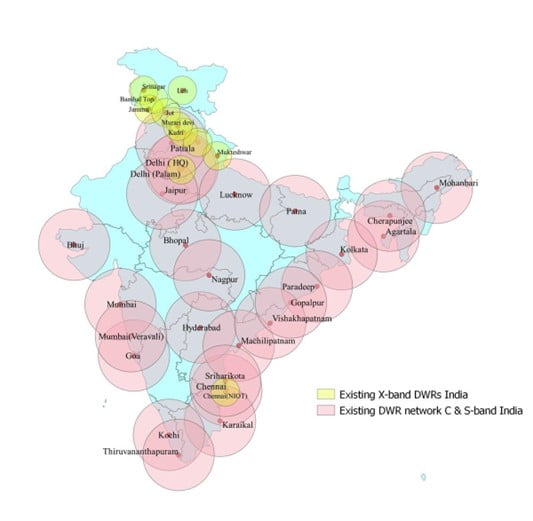ARCHIVES
Syllabus
- GS-3: Science and Technology- developments and their applications and effects in everyday life.
Context: Union Minister of State Science & Technology; Minister of State Earth Sciences; MoS PMO, Personnel, Public Grievances, Pensions, Atomic Energy and Space said, Entire Country will be covered by Doppler Weather Radar Network by 2025
- According to the Annual Statement on Climate of India 2022 issued by the India Meteorological Department (IMD), 2,227 extreme weather-related deaths in India.

What is Doppler effect?

- Doppler Effect refers to the change in Wave Frequency during the relative motion between a wave source and its observer.
- It was discovered by Christian Johann Doppler who described it as the process of increase or decrease of starlight that depends on the relative movement of the star.
- Doppler Effect works on both light and sound objects.
- For instance, when a sound object moves towards you, the frequency of the sound waves increases, leading to a higher pitch.
- Conversely, if it moves away from you, the frequency of the sound waves decreases and the pitch comes down.
- The drop in pitch of ambulance sirens as they pass by and the shift in red light are common examples of the Doppler Effect.
- Edwin Hubble made the discovery that the universe expands as a consequence of the Doppler Effect. It has important applications in the fields of astronomy and space technology.
- The use of Doppler Effect in astronomy in relation to light waves depends on the fact that the spectra of stars are not constant.
- Different stars exhibit different absorption lines at defined frequencies, but Doppler Effect is identifiable only when these absorption lines are away from these defined frequencies.
- There are various applications of Doppler Effect. It is used in:
- Astronomy
- Radar
- Medical imaging and blood flow managemen
- Flow management
- Velocity profile management
- Satellite communication
- Audio
- Vibration measurement
What is RADAR?
- RADAR is the expansion for Radio, Detection and Ranging.
- Its basic components are a transmitter, receiver, antenna, power supply system, signal processing and high computing devices.
- It works on the principle of electromagnetic waves sent out by the transmitter. The same wave that strikes an object/dense medium is reflected back to the receiver.
- The distance up to the object is determined based on the speed of the electromagnetic wave, and the time to travel to the object and back.
- There are at least ten types of radars.
- The Ground Penetrating Radar studies the Earth’s crust up to 9-metre in depth and is being used by the Defence Geoinformatics Research Establishment (DGRE) at Joshimath, Uttarakhand.
- The InSAR (Inferometric Synthetic Aperture Radar) that makes high-density measurements over large areas by using radar signals from Earth-orbiting satellites and measures changes in land-surface is also being used in Joshimath and other parts of Uttarakhand.
What are Doppler Radars?
- A Doppler Radar is a specialised radar that uses the Doppler effect to produce velocity data about objects at a distance.
- When the source and the signal are in relative motion to each other, there is a change in the frequency observed by the observer. This is called the Doppler effect. If they are moving closer, the frequency increases and vice versa.
- A Doppler Weather Radar (DWR) works on the Doppler principle. It is designed to improve precision in long-range weather forecasting and surveillance using a parabolic dish antenna.
- DWR has the equipment to measure rainfall intensity, wind shear and velocity and locate a storm centre and the direction of a tornado or gust front.
- Unlike others, a DWR has the ability to detect air motion, wind, speed of wind, rains, temperature, thunderstorms, hail, squalls, lightning, cyclones and cloud movements and volumetric analysis of cloud and reflectivity index, among others.
- It costs approximately ₹10-20 crore per unit. Operation and maintenance cost depending on type is generally ₹20-40 lakh per annum.
- As on January 15, 2023, the country has 37 DWRs. These are mainly spread across the plains. But mountainous and coastal terrain requires more radars, which are being procured.
- By 2024-25, India is expected to have 25 more DWRs taking the total number to 62 radars. That would improve forecast precision.
How have DWRs improved the weather forecast?
The major advantages of DWRs are, they:
- cover the entire country
- give the most precise detection of weather parameters including dynamic weather events turbulence, cyclones, thunderstorms or lightning
- alone do volumetric analysis of clouds that help in the quantification of rain forecasts and cyclonic intensity and precipitation; and
- precisely detect in real-time normal or routine events
Their best and famously documented use is in cyclone forecasting.
- As a cyclone comes within a 200 km range of the coast, the DWRs begin tracking it. This enables almost error-free forecasts with pinpoint precision.
- DWRs are also of great help in long-time lightning forecast of up to three to five days, down to 24 hours or even nowcast.
- DWRs are one of the most popular radars. The Indian Army and Air Force have deployed the Indian Doppler Radar (INDRA) for the detection of aircraft and other objects in the air.
Main Practice Question: Explain the working of Doppler Radar and enumerate its advantages.
Note: Write answer his question in the comment section.















